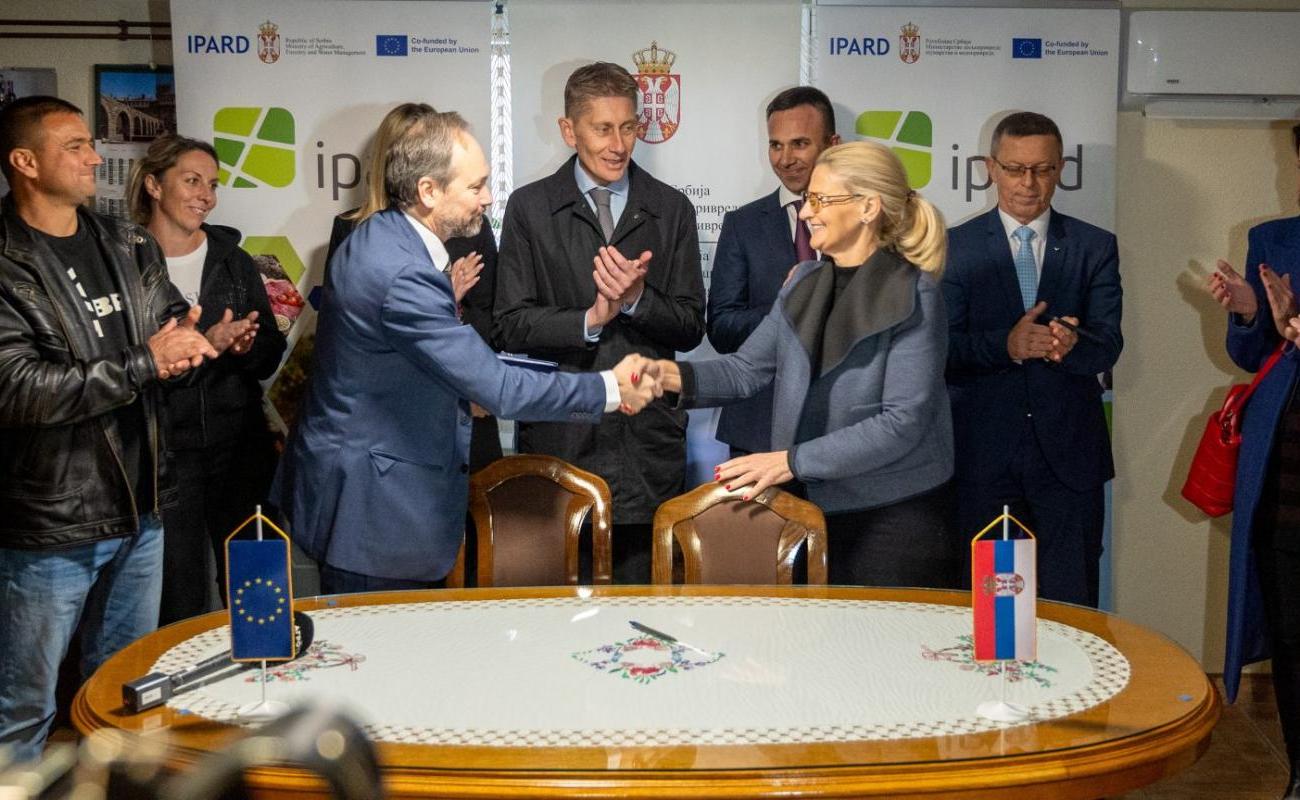The EU gives EUR 288 million for Serbian farmers

Today, Emanuele Giaufret, the Ambassador of the European Union to Serbia, co-signed and handed over the new Financing Agreement for the European Union’s latest assistance package for Serbia’s agricultural sector. The agreement worth 288 million euros of EU assistance was co-signed and handed to Tanja Miščević, Minister of European Integration, and Aleksandar Martinović, Minister of Agriculture, Forestry, and Water Management in the village of Tolić near Mionica (West Serbia). The European funds will be available for the benefit of Serbian farmers, agro processors and to stimulate rural development. The event included a visit to one of the previous beneficiaries of EU assistance for Serbian farmers, Srđan Miletić, and his poultry farm.
The new funds come out of the IPARD programme of the European Union– Instrument for Pre-Accession Assistance in Rural Development. The programme has already started its operation, and Serbian farmers have had the opportunity to apply for funds under this tranche in two open calls so far.
On that occasion, Ambassador Giaufret stated this was a significant contribution to developing the agricultural sector and emphasised:
„The EU cares for Serbian farmers. We work to support them and make sure that upon accession, when Serbian farmers will become EU farmers, they will able to compete and contribute to our agricultural sector. This significant funding of EUR 288 Milion in donation will empower farmers, agro-processors, and rural communities to tackle challenges and enhance their market competitiveness and boost rural development in areas like tourism. The funding under the European Union’s IPARD programme has been substantially increased, reflecting the EU’s commitment to these goals, as we look at Serbia as a future EU Member State. Serbia will have to utilise this money well and increase its absorption capacities to make best use of these funds. It is a good boost to Serbia’s agriculture! And it is much more than before! So I wish to encourage all farmers to apply for these funds. The EU has opportunities for you.“
Minister Martinovic stated the following:
“Within the IPARD III program, the new non-refundable funds that the European Union allocates to Serbia in the agricultural sector have increased by about 65% compared to the IPARD II program, and such support is extremely important for both our country and our agricultural producers. We have already started implementing the IPARD III program by issuing public calls, and the interest among users across the country is high, as evidenced by the number of applications submitted. Farmer Srđan Miletić, whose farm we visited today, represents a true example of an IPARD II program beneficiary, and precisely because of such examples of best practices, the Ministry of Agriculture and the Republic of Serbia are continuously working to provide opportunities for improving agricultural production and the development of Serbian agriculture. I am confident that we will have equally successful examples through the new IPARD III development program,” stated Minister Martinović.
“IPARD III is aimed directly at agricultural producers, specifically targeting legal entities and individuals in the regions of Belgrade, Vojvodina, Šumadija, as well as western, southern, and eastern Serbia. They will be able to acquire equipment and machinery, construct or renovate agricultural facilities to meet European standards in hygiene, food safety, animal welfare, and environmental protection, while improving their production, processing capabilities, and capacity to enter the EU market. This programme also serves as preparation for accessing significantly larger European funds, which will become available to local farmers and processors upon Serbia’s accession to EU membership.“
One of the good examples of IPARD support is Srđan Miletić’s farm.
“Through the IPARD program, I applied for incentives for investments in the physical assets of agricultural holdings – the Sixth Public Call for Measure 1 in the meat sector. I secured the right to build a facility for poultry fattening and housing, as well as equipment for ventilation, feeding, and watering animals. This has allowed me to improve production and become competitive. Without the support of the IPARD program, I would not have been able to realize this project at this time. Such support is extremely important for us producers, and I encourage all interested farmers to look at my example to see that IPARD is not as complicated as many think, that significant amounts invested can be returned, and that this is the best way to improve their production,” stated beneficiary Srđan Miletić.
So far, 17 IPARD public calls have been launched, resulting in over 1,500 signed contracts, with more than 1,200 payments made to Serbian farmers and food producers.
The European Union has supported the Serbian agricultural sector with more than EUR 150 million since 2001, with an additional EUR 175 million of EU support made available for farmers, agroprocessors under the IPARD II programme.. The current IPARD III programme will bring even more opportunities to Serbian farmers – they will have access to another EUR 288 million of EU support, which with the national contribution and their own participation could lead to a total effect of more than EUR 580 million. The main goals of support within IPARD are increasing the competitiveness of Serbian farmers, preserving the environment and biodiversity, supporting rural businesses and communities, and developing rural infrastructure.
The EU market traditionally represents the most important export destination for Serbian agricultural products with over a half of agricultural exports being shipped to the EU.
Serbia’s agricultural exports to the EU quadrupled over the past decade, from EUR 640 million in 2009 to EUR 2.4 billion in 2022, while last year that figure was more than 2.2 billion. At the same time, Serbian imports of agricultural products from the EU have been on a steady rise during the previous decade from EUR 440 million in 2009 to over EUR 2.4 billion in 2023.
